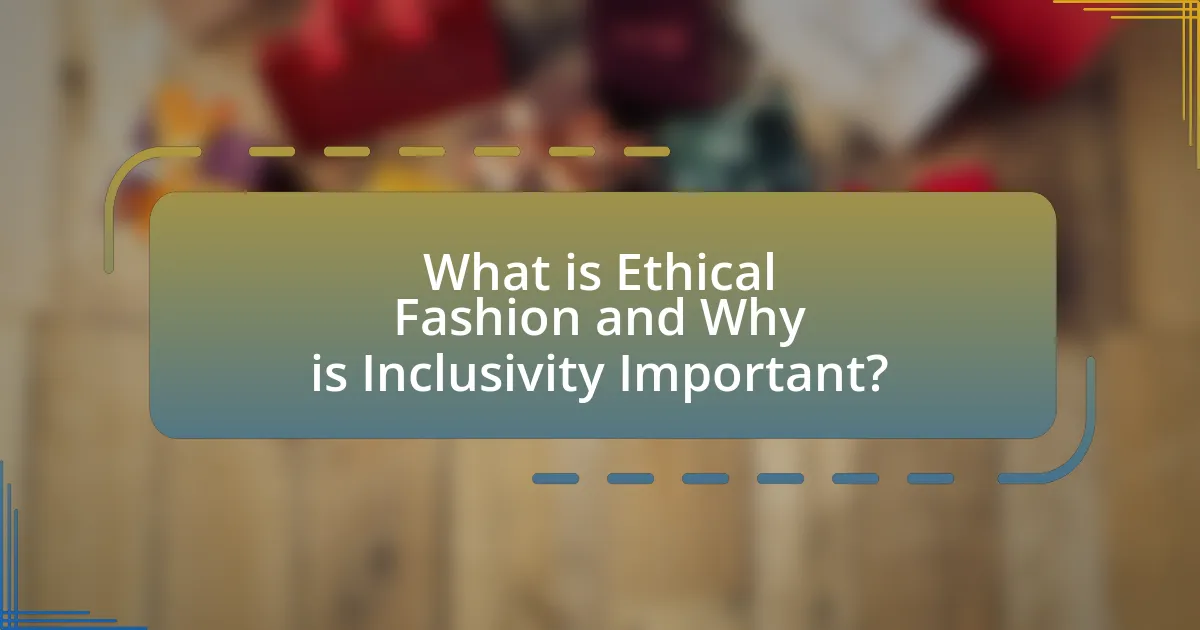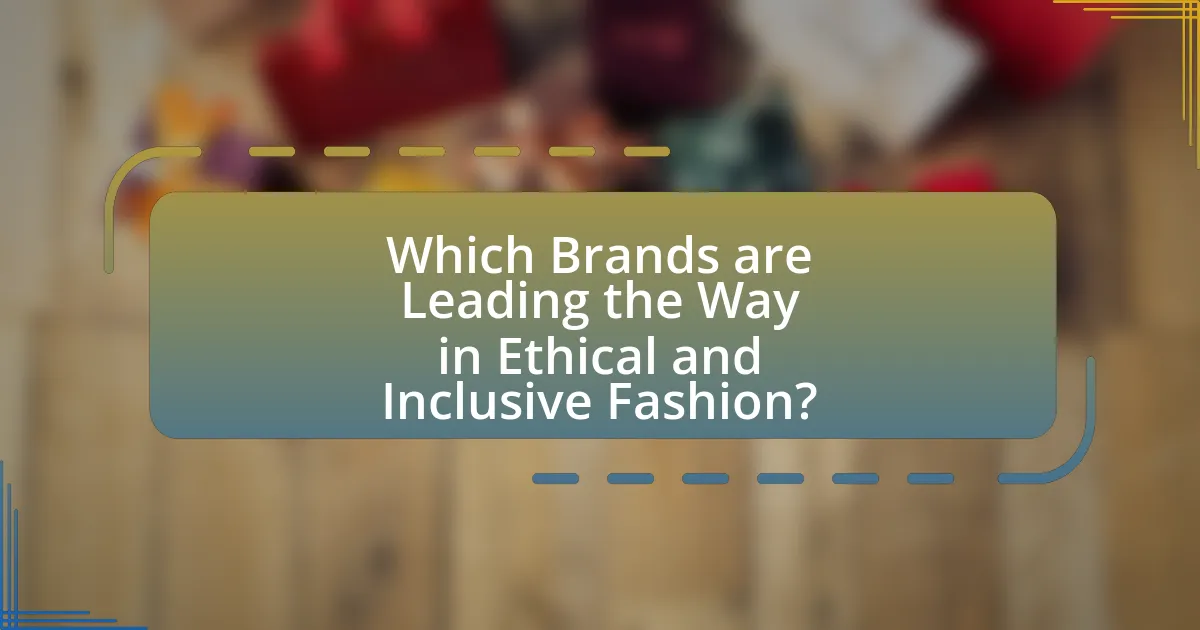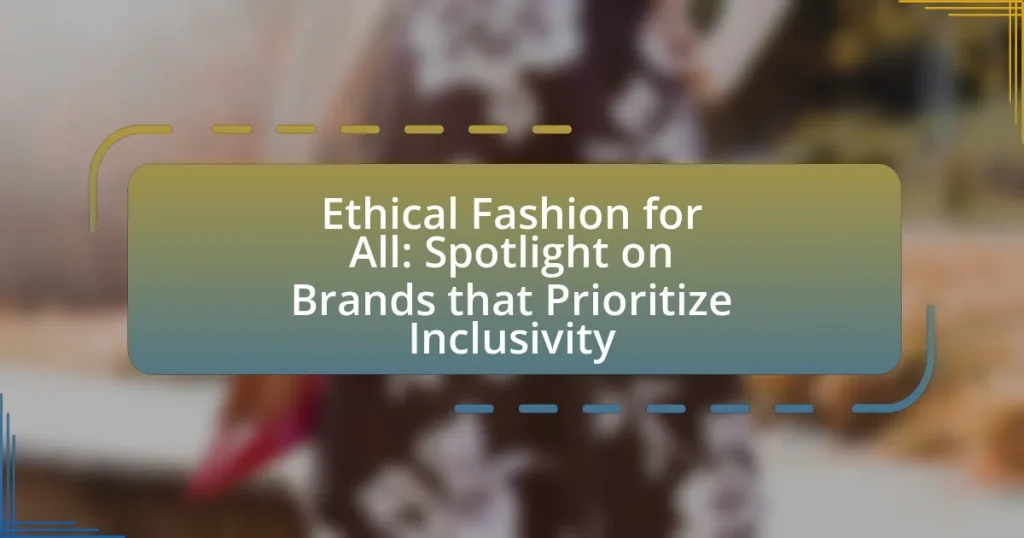Ethical fashion is defined as clothing and accessories produced with a focus on social and environmental responsibility, emphasizing fair labor practices and sustainable materials. Inclusivity plays a crucial role in ethical fashion by ensuring representation of diverse body types, genders, and cultural backgrounds, which enhances customer loyalty and market reach. The article explores the differences between ethical and traditional fashion, core principles of ethical fashion, and the significance of sustainability and inclusivity. It highlights leading brands that exemplify these values, discusses the challenges faced by ethical and inclusive fashion brands, and provides practical tips for consumers to support and identify truly ethical and inclusive brands.

What is Ethical Fashion and Why is Inclusivity Important?
Ethical fashion refers to clothing and accessories produced in a manner that prioritizes social and environmental responsibility, ensuring fair labor practices, sustainable materials, and minimal environmental impact. Inclusivity is important in ethical fashion because it ensures that diverse body types, genders, and cultural backgrounds are represented and catered to, promoting equality and accessibility in the fashion industry. Research indicates that brands that embrace inclusivity not only enhance customer loyalty but also expand their market reach, as seen in the 2019 report by McKinsey & Company, which highlighted that inclusive brands can capture a larger share of the market by appealing to a broader audience.
How does ethical fashion differ from traditional fashion?
Ethical fashion differs from traditional fashion primarily in its commitment to sustainability and social responsibility. While traditional fashion often prioritizes profit and rapid production, ethical fashion emphasizes fair labor practices, environmentally friendly materials, and transparency in the supply chain. For instance, ethical brands frequently ensure that workers receive fair wages and work in safe conditions, contrasting with traditional practices that may exploit labor for cost reduction. Additionally, ethical fashion often utilizes sustainable materials, reducing environmental impact, whereas traditional fashion may rely on harmful practices that contribute to pollution and waste.
What are the core principles of ethical fashion?
The core principles of ethical fashion include sustainability, fair labor practices, and transparency. Sustainability focuses on minimizing environmental impact through eco-friendly materials and production methods. Fair labor practices ensure that workers receive fair wages and safe working conditions, promoting social equity. Transparency involves openly sharing information about sourcing, production processes, and labor conditions, allowing consumers to make informed choices. These principles are supported by various organizations and certifications, such as the Global Organic Textile Standard, which verifies sustainable practices in the fashion industry.
Why is sustainability a key component of ethical fashion?
Sustainability is a key component of ethical fashion because it addresses environmental impact and promotes responsible resource use. Ethical fashion brands prioritize sustainable practices to reduce waste, minimize carbon footprints, and ensure fair labor conditions. For instance, the fashion industry is responsible for approximately 10% of global carbon emissions, highlighting the urgent need for sustainable approaches. By adopting eco-friendly materials and production methods, ethical fashion brands contribute to a more sustainable future while also appealing to consumers who value environmental responsibility.
What does inclusivity mean in the context of fashion?
Inclusivity in the context of fashion refers to the practice of designing, producing, and marketing clothing that accommodates diverse body types, genders, ethnicities, and abilities. This approach ensures that fashion is accessible and representative of all individuals, moving beyond traditional standards that often exclude marginalized groups. For instance, brands like Savage X Fenty have gained recognition for offering a wide range of sizes and featuring models of various backgrounds, which highlights the importance of representation in the industry.
How can brands demonstrate inclusivity in their practices?
Brands can demonstrate inclusivity in their practices by actively incorporating diverse representation in their marketing, product offerings, and workplace culture. This includes featuring models of various ethnicities, body types, genders, and abilities in advertising campaigns, which has been shown to resonate with a broader audience and foster a sense of belonging. For instance, a study by the American Psychological Association found that diverse representation in media positively impacts consumer perception and brand loyalty. Additionally, brands can implement inclusive sizing and adaptive clothing lines to cater to individuals with different body shapes and disabilities, thereby expanding their market reach and promoting accessibility. By prioritizing these practices, brands not only enhance their social responsibility but also align with consumer expectations for inclusivity in today’s market.
What are the benefits of prioritizing inclusivity in fashion?
Prioritizing inclusivity in fashion enhances brand loyalty and market reach. By catering to diverse body types, ethnicities, and gender identities, brands can attract a broader customer base, leading to increased sales. For instance, a study by McKinsey & Company found that brands with diverse leadership teams are 35% more likely to outperform their competitors in profitability. Additionally, inclusivity fosters a positive brand image, as consumers increasingly prefer companies that reflect their values and promote social responsibility. This alignment with consumer expectations can result in higher customer retention and advocacy, ultimately benefiting the brand’s bottom line.

Which Brands are Leading the Way in Ethical and Inclusive Fashion?
Brands leading the way in ethical and inclusive fashion include Patagonia, Eileen Fisher, and Reformation. Patagonia is recognized for its commitment to environmental sustainability and fair labor practices, with 68% of its products made from recycled materials. Eileen Fisher emphasizes size inclusivity and sustainable practices, offering sizes ranging from XXS to 3X and using organic fibers. Reformation focuses on transparency and eco-friendly materials, providing detailed information about the environmental impact of each product. These brands exemplify a commitment to ethical production and inclusivity in the fashion industry.
What are some notable brands that prioritize inclusivity?
Notable brands that prioritize inclusivity include Fenty Beauty, Aerie, and Savage X Fenty. Fenty Beauty, founded by Rihanna, revolutionized the cosmetics industry by offering an extensive range of foundation shades for diverse skin tones, addressing a significant gap in the market. Aerie, a lingerie and activewear brand, promotes body positivity by featuring unretouched photos of models of various sizes, which has resonated with consumers seeking authenticity. Savage X Fenty, also by Rihanna, emphasizes inclusivity by providing a wide range of sizes and showcasing diverse models in its campaigns, further challenging traditional beauty standards. These brands exemplify a commitment to inclusivity through their products and marketing strategies.
How do these brands incorporate ethical practices into their business models?
These brands incorporate ethical practices into their business models by prioritizing sustainable sourcing, fair labor practices, and transparency in their supply chains. For instance, many brands utilize organic or recycled materials to minimize environmental impact, while ensuring that workers are paid fair wages and work in safe conditions. Additionally, brands often publish detailed reports on their sourcing and labor practices, allowing consumers to make informed choices. This commitment to ethical practices not only enhances brand reputation but also aligns with the growing consumer demand for responsible fashion, as evidenced by a 2021 survey indicating that 66% of global consumers are willing to pay more for sustainable brands.
What unique approaches do these brands take to ensure inclusivity?
Brands prioritize inclusivity by implementing diverse sizing, adaptive designs, and culturally representative marketing strategies. For instance, some brands offer extended size ranges that cater to a wider array of body types, ensuring that all customers can find suitable clothing. Additionally, adaptive clothing lines are created for individuals with disabilities, featuring modifications like magnetic closures or adjustable fits. Furthermore, inclusive marketing campaigns showcase models from various ethnic backgrounds, genders, and abilities, reflecting the diversity of their customer base. These approaches not only enhance accessibility but also foster a sense of belonging among consumers, as evidenced by increased brand loyalty and positive customer feedback.
How do consumer choices impact the success of inclusive brands?
Consumer choices significantly impact the success of inclusive brands by driving demand for products that cater to diverse demographics. When consumers prioritize inclusivity in their purchasing decisions, they contribute to the financial viability and market growth of brands that embrace diverse representation, sizes, and cultural backgrounds. For instance, a study by McKinsey & Company found that brands with diverse leadership teams are 21% more likely to outperform their peers in profitability, indicating that consumer preference for inclusivity can lead to better business outcomes. Additionally, the rise of social media has amplified consumer voices, allowing them to advocate for brands that align with their values, further influencing brand success.
What role does social media play in promoting these brands?
Social media plays a crucial role in promoting brands that prioritize inclusivity in ethical fashion by providing a platform for direct engagement with consumers. These brands utilize social media to showcase their values, share stories of inclusivity, and connect with diverse audiences, thereby enhancing brand visibility and loyalty. For instance, brands like Reformation and Aerie have successfully leveraged platforms like Instagram to highlight their commitment to body positivity and sustainable practices, resulting in increased consumer awareness and sales. According to a 2021 report by Sprout Social, 70% of consumers feel more connected to brands that engage with them on social media, underscoring the effectiveness of these platforms in fostering community and driving brand advocacy.
How can consumers support ethical and inclusive fashion brands?
Consumers can support ethical and inclusive fashion brands by choosing to purchase from companies that prioritize sustainable practices and diversity in their offerings. This support can manifest through actions such as researching brands’ ethical standards, opting for products made from eco-friendly materials, and advocating for fair labor practices. For instance, a 2021 survey by McKinsey & Company found that 67% of consumers consider sustainability when making fashion purchases, indicating a growing demand for responsible brands. Additionally, consumers can amplify their support by sharing their positive experiences on social media, thereby influencing others to consider ethical options.

What Challenges Do Ethical and Inclusive Fashion Brands Face?
Ethical and inclusive fashion brands face significant challenges, primarily related to supply chain transparency and consumer awareness. These brands often struggle with sourcing sustainable materials while ensuring fair labor practices, which can lead to higher production costs. Additionally, many consumers lack understanding of the benefits of ethical fashion, resulting in lower demand compared to fast fashion alternatives. According to a 2021 report by McKinsey & Company, only 30% of consumers are willing to pay more for sustainable products, highlighting the financial hurdles these brands encounter. Furthermore, ethical brands must navigate the complexities of inclusivity, ensuring that their offerings cater to diverse body types and cultural backgrounds, which can complicate design and marketing strategies.
What are the common obstacles for brands in this sector?
Common obstacles for brands in the ethical fashion sector include high production costs, limited access to sustainable materials, and challenges in supply chain transparency. High production costs arise from the need for ethical labor practices and sustainable sourcing, which can significantly increase expenses compared to conventional fashion. Limited access to sustainable materials restricts brands from fully committing to eco-friendly practices, as these materials may not be readily available or affordable. Additionally, challenges in supply chain transparency make it difficult for brands to ensure that all aspects of their production adhere to ethical standards, leading to potential reputational risks and consumer distrust.
How do economic factors influence the growth of ethical fashion?
Economic factors significantly influence the growth of ethical fashion by shaping consumer purchasing power and demand for sustainable products. As disposable incomes rise, consumers are more likely to invest in ethical fashion brands that prioritize sustainability and social responsibility. For instance, a report by McKinsey & Company indicates that 67% of consumers consider sustainability when making a purchase, highlighting a growing market for ethical fashion. Additionally, economic downturns can lead to increased scrutiny of fast fashion practices, prompting consumers to seek more sustainable alternatives. This shift is further supported by the rise of online platforms that facilitate access to ethical brands, making them more visible and appealing to a broader audience.
What challenges do brands face in sourcing sustainable materials?
Brands face significant challenges in sourcing sustainable materials, primarily due to limited availability and higher costs. The supply chain for sustainable materials often lacks the scale and infrastructure of conventional materials, making it difficult for brands to secure consistent and reliable sources. Additionally, the price of sustainable materials can be substantially higher, which poses a financial burden, especially for smaller brands. According to a report by McKinsey & Company, the cost of sustainable materials can be up to 30% more than traditional options, impacting profit margins. Furthermore, brands encounter difficulties in verifying the sustainability claims of suppliers, as transparency in sourcing practices is often lacking. This complexity in the supply chain can lead to challenges in maintaining ethical standards while meeting consumer demand for sustainability.
How can brands overcome these challenges to thrive?
Brands can overcome challenges in ethical fashion by prioritizing transparency, engaging in sustainable practices, and fostering inclusivity in their marketing and product offerings. Transparency builds consumer trust; for instance, brands like Patagonia openly share their supply chain practices, which enhances credibility. Sustainable practices, such as using eco-friendly materials and ethical labor, not only reduce environmental impact but also attract conscious consumers; a report by McKinsey indicates that 66% of consumers are willing to pay more for sustainable brands. Lastly, fostering inclusivity through diverse representation in marketing and product lines ensures that brands resonate with a broader audience, as seen with brands like Aerie, which has successfully embraced body positivity and inclusivity, leading to increased sales and customer loyalty.
What strategies can brands implement to enhance their inclusivity?
Brands can enhance their inclusivity by implementing diverse representation in marketing and product offerings. This strategy involves showcasing models of various ethnicities, body types, and abilities in advertising campaigns, which has been shown to resonate with a broader audience and foster a sense of belonging. For instance, a study by the American Psychological Association found that representation in media positively influences consumer perception and brand loyalty. Additionally, brands can adopt inclusive sizing and gender-neutral options, catering to a wider range of customers. Research from McKinsey & Company indicates that companies with diverse teams are 35% more likely to outperform their competitors, highlighting the business case for inclusivity. By actively engaging with underrepresented communities and soliciting feedback, brands can further refine their offerings to meet diverse needs, thereby enhancing their overall inclusivity.
How can collaboration within the industry foster better practices?
Collaboration within the fashion industry can foster better practices by enabling brands to share resources, knowledge, and innovative solutions that promote ethical standards. When companies work together, they can establish common guidelines for sustainability, labor rights, and inclusivity, which can lead to a more unified approach to ethical fashion. For instance, initiatives like the Fashion Pact, which includes major brands committed to environmental goals, demonstrate how collective action can drive significant change in reducing carbon footprints and improving supply chain transparency. This collaborative effort not only enhances brand credibility but also encourages consumer trust and loyalty, ultimately leading to a more responsible industry.
What are some practical tips for consumers to support ethical fashion?
Consumers can support ethical fashion by choosing to buy from brands that prioritize sustainable practices and fair labor conditions. This includes researching brands’ supply chains to ensure they use eco-friendly materials and pay fair wages to workers. Additionally, consumers can opt for second-hand clothing, which reduces waste and promotes a circular economy. Supporting local artisans and small businesses also contributes to ethical fashion by fostering community and reducing carbon footprints associated with long-distance shipping. According to a 2021 report by the Ethical Fashion Initiative, consumers who prioritize ethical brands can significantly influence industry standards and practices.
How can consumers identify truly ethical and inclusive brands?
Consumers can identify truly ethical and inclusive brands by examining their transparency, labor practices, and commitment to diversity. Ethical brands often provide detailed information about their supply chains, including sourcing materials and labor conditions, which can be verified through third-party certifications like Fair Trade or B Corp. Additionally, inclusive brands actively promote diversity in their marketing, product offerings, and hiring practices, ensuring representation across various demographics. Research indicates that 66% of consumers are willing to pay more for sustainable brands, highlighting the demand for ethical practices. Brands that align with these values typically engage in community initiatives and support social causes, further demonstrating their commitment to inclusivity and ethics.
What actions can consumers take to promote inclusivity in fashion?
Consumers can promote inclusivity in fashion by supporting brands that prioritize diverse sizing, representation, and ethical practices. By choosing to purchase from companies that offer a wide range of sizes and showcase models of various ethnicities, body types, and abilities, consumers can drive demand for more inclusive practices in the industry. Research indicates that brands with diverse representation not only attract a broader customer base but also enhance brand loyalty, as consumers increasingly seek alignment with their values. For instance, a study by McKinsey & Company found that companies with more diverse workforces are 35% more likely to outperform their competitors, highlighting the business case for inclusivity.












